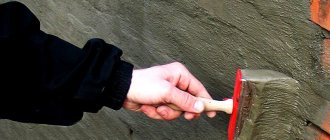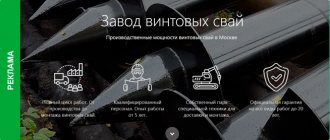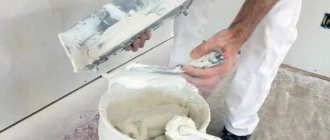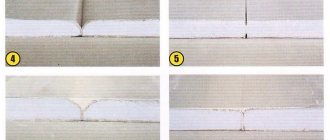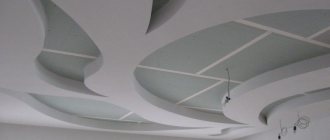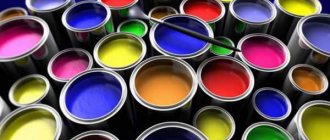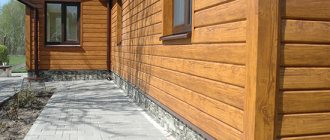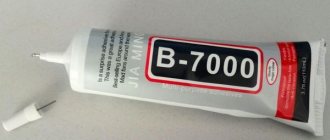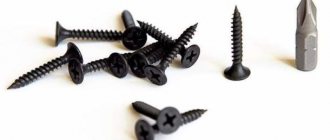Priming of walls and floors is carried out during construction to ensure reliable adhesion of finishing materials to the wall surface. When choosing a primer, you need to pay attention to its technical characteristics and composition. The type of surface, humidity in the room, and further finishing method are taken into account.
Knauf's product range includes mixtures to suit any need. The deep penetration primer Tiefengrund Knauf is popular. It strengthens the surface of the base, reduces its ability to absorb, and improves the adhesion of the finish. Due to its increased penetration ability, it is suitable for materials with small pores.
About Knauf primer
Tiefengrund Knauf is a universal primer that is suitable for both external and internal work. It dries quickly, has no color or specific odor. Provides deep penetration into the surface, completely safe for others. Penetrating primer does not contain plasticizers or solvents. The composition contains fine particles of artificial resins that are resistant to saponification.
The primer is applied in an even layer to the surface, ensuring after drying good adhesion to paint, glue and other finishing materials, which reduces their overall consumption, and therefore saves money on the purchase of building materials. After treating the surface, a protective layer is formed on it, preventing the development of mold, mildew, and corrosion, minor construction flaws, cracks and chips are hidden, the surface continues to breathe and allow water vapor to pass through.
Knauf primer is used for pre-treatment and strengthening of surfaces, including brick, concrete, plaster, etc.
The primer must be used within a year from the date of its manufacture. The container with the composition must be stored closed at an ambient temperature above zero. Freezing of the soil is prohibited.
The main advantages and characteristics of the Knauf Tiefengrund primer
Priming of walls and floors is carried out during construction to ensure reliable adhesion of finishing materials to the wall surface.
When choosing a primer, you need to pay attention to its technical characteristics and composition. The type of surface, humidity in the room, and further finishing method are taken into account. Knauf's product range includes mixtures to suit any need. The deep penetration primer Tiefengrund Knauf is popular. It strengthens the surface of the base, reduces its ability to absorb, and improves the adhesion of the finish. Due to its increased penetration ability, it is suitable for materials with small pores.
About Knauf primer
Tiefengrund Knauf is a universal primer that is suitable for both external and internal work. It dries quickly, has no color or specific odor. Provides deep penetration into the surface, completely safe for others. Penetrating primer does not contain plasticizers or solvents. The composition contains fine particles of artificial resins that are resistant to saponification.
The primer is applied in an even layer to the surface, ensuring after drying good adhesion to paint, glue and other finishing materials, which reduces their overall consumption, and therefore saves money on the purchase of building materials. After treating the surface, a protective layer is formed on it, preventing the development of mold, mildew, and corrosion, minor construction flaws, cracks and chips are hidden, the surface continues to breathe and allow water vapor to pass through.
Knauf primer is used for pre-treatment and strengthening of surfaces, including brick, concrete, plaster, etc.
The primer must be used within a year from the date of its manufacture. The container with the composition must be stored closed at an ambient temperature above zero. Freezing of the soil is prohibited.
Areas of application for Tiefengrund Knauf primer
The use of a strengthening mixture improves the adhesion of the finish to the following surfaces:
- plasterboard and gypsum fiber sheets;
- plaster made of gypsum and cement;
- tongue-and-groove gypsum slabs;
- screed made of gypsum and cement.
A penetrating primer is applied before painting walls, laying floor or wall tiles, tiles, before puttingtying and wallpapering. It is used for interior and exterior work, when finishing facades.
Advantages
Advantages of Tiefengrund Knauf primer.
- It is not dangerous and does not release toxic substances into the environment.
- It is colorless and odorless.
- The primer contains no solvents.
- A 10-liter bucket is enough to treat 100 m2 of various surfaces.
- Designed for weak foundations, strengthening and protecting them from self-destruction.
- Not afraid of changes in temperature and humidity in the environment.
- The country of origin is Germany, there is a certificate of conformity with GOST. Production quality control is ensured at every stage by the company itself and independent experts.
- Dries quickly.
- Increases the adhesion of surfaces, increases their density and strength.
- Provides complete air exchange and vapor permeability.
- Reduces finishing consumption.
The advantages of choosing Knauf Tiefengrund are demonstrated by technical parameters.
Technical characteristics of Tiefengrund
| Characteristic | Meaning |
| Consumption per 1m2 | 0.1 kg |
| Drying time | 3 hours |
| Colors | white, matte |
| Frost resistance | 5 cycles |
| Package | hermetically sealed bucket without film sealing |
| Packing | 5 and 10 kilograms |
| Shelf life in undamaged containers | 12 months |
| Depth of penetration into the base | ≈ 10 cm |
| Degree of penetration into porous materials | deep |
| Smell | absent |
| Can be diluted with water | proportion 1:1 |
The final primer consumption per 1 m2 depends on the type of surface, tool and number of layers applied.
Certificate of conformity
The manufacturing company Knauf has a certificate of product compliance with high European quality standards. The document indicates that the soil was subjected to all necessary research and control, which ultimately confirmed the product’s compliance with GOST.
Certification of the composition consisted of:
- selection of material for laboratory research;
- analysis of production and technological manufacturing processes;
- certification based on indicators.
After all control studies, the composition is labeled and certified.
The price range is large, the cost is determined depending on the region, volume and number of units of goods purchased at a time.
- On average, in the Moscow region, a 5-liter jar is bought for 400 rubles.
- A 10 liter bucket will be more expensive, its price exceeds 845 rubles.
- For wholesale buyers, offline/online construction stores often organize promotions, under the terms of which, when purchasing from 20-30 buckets, the cost of 1 kg of the mixture will not exceed 40 rubles. The soil has a wide range of applications and is useful on all construction sites.
Features of application
Regardless of the choice of primer mixture, it is important to properly prepare the surface. Before applying it, the surface to be treated must be cleaned and degreased. If there are remnants of old paint, varnish or any other finish on the wall or ceiling, they must be removed, washed off if necessary and dried.
The jar is carefully opened, its contents are diluted with water in a 1:1 ratio. To check whether the dilution level of the primer is suitable for the base on which it will be applied, you need to make several test strokes. Testing will help you evaluate how many layers the mixture should be applied.
The manufacturer does not recommend the use of primer on surfaces coated with an adhesive-oil composition.
Tiefengrund can be applied with a roller, brush, spray or spray gun. Immediately after the first layer, you need to apply the second one, without waiting for it to dry.
It is necessary to ensure that the consumption rate of the mixture is not exceeded, this will lead to its drainage and the formation of drips. If a plasterboard surface is being primed, it is enough to apply 1 layer.
Safety precautions must be observed:
- Under no circumstances should residues be discharged into sewers or water bodies;
- if the composition gets into the eyes or any other area of the mucous membrane, it must be thoroughly rinsed with a stream of clean water;
- the solution cannot be disposed of as household waste;
- It is advisable to use personal protective equipment (gloves, thick clothing, a respirator and goggles when spraying).
If there is still primer left in the jar after use, it must be tightly closed and stored at a temperature not lower than 0°, but no more than a year from the moment of opening.
Conclusion
Tiefengrund Knauf is a deeply penetrating primer into surfaces with large or small pores. Strengthens the base and reduces the consumption of future paintwork. Definitely recommended for use. You need to buy only a high-quality mixture, in specialized stores, if you have a certificate,
Areas of application for Tiefengrund Knauf primer
The use of a strengthening mixture improves the adhesion of the finish to the following surfaces:
- plasterboard and gypsum fiber sheets;
- plaster made of gypsum and cement;
- tongue-and-groove gypsum slabs;
- screed made of gypsum and cement.
A penetrating primer is applied before painting walls, laying floor or wall tiles, tiles, before puttingtying and wallpapering. It is used for interior and exterior work, when finishing facades.
Advantages
Advantages of Tiefengrund Knauf primer.
- It is not dangerous and does not release toxic substances into the environment.
- It is colorless and odorless.
- The primer contains no solvents.
- A 10-liter bucket is enough to treat 100 m2 of various surfaces.
- Designed for weak foundations, strengthening and protecting them from self-destruction.
- Not afraid of changes in temperature and humidity in the environment.
- The country of origin is Germany, there is a certificate of conformity with GOST. Production quality control is ensured at every stage by the company itself and independent experts.
- Dries quickly.
- Increases the adhesion of surfaces, increases their density and strength.
- Provides complete air exchange and vapor permeability.
- Reduces finishing consumption.
The advantages of choosing Knauf Tiefengrund are demonstrated by technical parameters.
Technical characteristics of Tiefengrund
| Characteristic | Meaning |
| Consumption per 1m2 | 0.1 kg |
| Drying time | 3 hours |
| Colors | white, matte |
| Frost resistance | 5 cycles |
| Package | hermetically sealed bucket without film sealing |
| Packing | 5 and 10 kilograms |
| Shelf life in undamaged containers | 12 months |
| Depth of penetration into the base | ≈ 10 cm |
| Degree of penetration into porous materials | deep |
| Smell | absent |
| Can be diluted with water | proportion 1:1 |
The final primer consumption per 1 m2 depends on the type of surface, tool and number of layers applied.
Primer Knauf Tiefengrund
Knauf Tiefengrund primer is used to treat walls, ceilings or floors to increase the adhesion of materials. The mixture is easy to use and has high quality characteristics. It strengthens the surface and makes it smoother, making it easier to apply a topcoat over the primer. Characteristics, properties and methods of using Knauf Tiefengrund primer are presented in this article.
Knauf Tiefengrund primer review
This type of primer is made according to a German recipe and meets the European quality standard. It differs from many analogues in its vapor permeability, but at the same time it is also a moisture-proof component of the wall. It contains environmentally friendly ingredients, hypoallergenic, and can be used without protective equipment. It is odorless and dries quickly, which is convenient when using the primer indoors.
Knauf Tiefengrund primer is used both outside and inside the building. The main requirement for the surface to be treated is strength and hardness. The mixture can be used to process:
- plasterboards and other substrates that absorb moisture;
- cement and gypsum screeds;
- gypsum and cement plaster;
- compacted monolithic concrete base;
- joints of gypsum board and gypsum board before using gypsum putty.
This primer is also often used as a starting mixture before plastering or before applying stucco elements to ensure better adhesion.
There are several types of Knauf Tiefengrund primer. They are similar in appearance, but there is a simple variety and one that can be frozen. True, you can only freeze it up to 5 times, and then it spoils. The packaging of such a product is marked “frost-resistant”.
Advantages of Knauf Tiefengrund primer
Specifications
The manufacturer Knauf produces high-quality products. This also applies to the Tiefengrund primer, as evidenced by its characteristics.
- Adhesive permeability up to 10 cm.
- Vapor permeability.
- White color.
- Matte gloss.
- The Knauf Tiefengrund primer layer dries in 2-3 hours.
- Consumption per 1 m² for single-layer application – 0.1 kg;
- The primer is a frost-resistant type, withstands frosts down to -40 degrees Celsius.
- Has no smell.
Advantages and disadvantages
This type of primer is known to many due to its benefits.
- Increases adhesion to the base when using wallpaper, paint, putty, ceramic tiles.
- Dries quickly.
- It features low consumption.
- It is safe and odorless - you can work with it without a respirator.
- Hides small cracks and defects, makes the wall smoother.
- Strengthens the base well on gypsum and chalk bases.
- Has deep penetration.
- Withstands changes in temperature and humidity.
- Does not insulate the room, allowing vapors to pass through the walls.
- Saves finishing materials.
The main disadvantage is the price. This product is considered affordable, but there are cheaper analogues.
Photo primer Knauf Tiefengrund
Features of application and consumption of Knauf Tiefengrund primer
Buying a Knauf Tiefengrund primer is half the battle, the main thing is to apply it correctly. First, prepare the surface - the wall. It is cleaned of dirt, old wallpaper (if there is any), stains, and then degreased. If it was previously treated with lime or some kind of peeling coating, then it must be completely cleaned off.
When the wall is ready, you can prime it. They use different tools for this, brushes, a roller, an air spray - whichever is more convenient for you. If the wall is loose and contains a lot of sand or other loose rocks, it is necessary to carry out the application according to the “wet on wet” principle. That is, the first layer of primer is applied, and then, immediately, until the wall is dry, the second layer is applied.
Thin, single layers are applied. If applied too generously, the mixture will literally run off, forming rough smudges. Sometimes additional dilution with water is required. In this case, you can add liquids up to 50%, no more! If the application is successful, then after drying, a thin but durable transparent film forms on the wall.
- Average consumption of Knauf Tiefengrund primer is 0.07-0.1 kg/m2;
- Total drying time is 3 hours.
Cost, packaging and storage
Knauf Tiefengrund primer is available in plastic, white buckets with a sealed lid (usually blue) and a metal handle. It is not sealed with film. Packed in 5 and 10 kg. The cost depends on the type of primer, displacement and can range from 165 to 870 rubles; wholesale will be a little cheaper.
The shelf life is 12 months if the jar is unopened. You can store it in a warehouse where it is neither hot nor cold, away from heating systems. The frost-resistant variety can withstand up to 5 frosts, but it is advisable not to freeze the mixture on purpose. If this happens, it is defrosted at room temperature, without heating or accelerating thawing, otherwise this may lead to damage to the primer. If the packaging is not marked frost-resistant, this means that freezing the primer is prohibited, otherwise it will quickly lose its quality!
Sources: https://evmaster.net/gruntovka-knauf-tifengrund https://vsyakraska.ru/shpatlevka/nado-li-gruntovat-steny-pered/
Certificate of conformity
The manufacturing company Knauf has a certificate of product compliance with high European quality standards. The document indicates that the soil was subjected to all necessary research and control, which ultimately confirmed the product’s compliance with GOST.
Certification of the composition consisted of:
- selection of material for laboratory research;
- analysis of production and technological manufacturing processes;
- certification based on indicators.
After all control studies, the composition is labeled and certified.
Price
The price range is large, the cost is determined depending on the region, volume and number of units of goods purchased at a time.
- On average, in the Moscow region, a 5-liter jar is bought for 400 rubles.
- A 10 liter bucket will be more expensive, its price exceeds 845 rubles.
- For wholesale buyers, offline/online construction stores often organize promotions, under the terms of which, when purchasing from 20-30 buckets, the cost of 1 kg of the mixture will not exceed 40 rubles. The soil has a wide range of applications and is useful on all construction sites.
Scope of application and consumption
The primary purpose of the Tiefengrund product is the treatment of walls/ceilings before finishing work. The purpose of its use is to increase the ability of the base to firmly adhere to the base and the desire to reduce the consumption of the same paint. Knauf Tiefengrund primer is used for subsequent painting of walls, laying tiles on walls/floors, wallpapering or puttying.
It is allowed to use Knauf even on top of gypsum moisture-absorbing plaster, gypsum plaster boards, and it can also be combined with self-leveling floors. That is, even on surfaces prone to self-destruction, the primer creates a durable film that does not interfere with air exchange. This soil is used both inside buildings and for exterior finishing activities.
Application of the product indoors
Material consumption when applying one layer is from 0.07 kg to 0.1 kg per 1 sq. m. In addition to 10 liter packaging, 5 liter buckets are also produced.
Features of application
Regardless of the choice of primer mixture, it is important to properly prepare the surface. Before applying it, the surface to be treated must be cleaned and degreased. If there are remnants of old paint, varnish or any other finish on the wall or ceiling, they must be removed, washed off if necessary and dried.
The jar is carefully opened, its contents are diluted with water in a 1:1 ratio. To check whether the dilution level of the primer is suitable for the base on which it will be applied, you need to make several test strokes. Testing will help you evaluate how many layers the mixture should be applied.
The manufacturer does not recommend the use of primer on surfaces coated with an adhesive-oil composition.
Tiefengrund can be applied with a roller, brush, spray or spray gun. Immediately after the first layer, you need to apply the second one, without waiting for it to dry.
It is necessary to ensure that the consumption rate of the mixture is not exceeded, this will lead to its drainage and the formation of drips. If a plasterboard surface is being primed, it is enough to apply 1 layer.
Safety precautions must be observed:
- Under no circumstances should residues be discharged into sewers or water bodies;
- if the composition gets into the eyes or any other area of the mucous membrane, it must be thoroughly rinsed with a stream of clean water;
- the solution cannot be disposed of as household waste;
- It is advisable to use personal protective equipment (gloves, thick clothing, a respirator and goggles when spraying).
If there is still primer left in the jar after use, it must be tightly closed and stored at a temperature not lower than 0°, but no more than a year from the moment of opening.
Features of use and application
Before applying the composition to the base, the primer can be diluted with water, but not more than 50%. It is important to carefully prepare the surface to reduce material consumption. Preparation includes cleaning the base from any contaminants, for example, dust, grease stains, crumbling old finishes, and at the end the base must be dried. Any loose areas or particles must be removed.
After preparing and cleaning the walls, it is important to perform test strokes to determine how much the primer can be thinned with water for a particular substrate. Each material has its own structure and absorbent characteristics, for example, it is enough to prime drywall with one layer, but more porous surfaces, for example, brick walls, often have to be treated with several layers. The manufacturer does not recommend applying tiefengrund to putty walls that are coated with oil-adhesive compounds.
As a tool for uniform distribution of the primer composition, you can use a construction brush or roller. In addition, spraying the substance using a spray gun or spray gun is allowed.
When the first layer is applied, the second can be applied immediately; you do not need to wait until the first layer has completely dried, but you must monitor the material consumption. You must not overuse the primer mixture, because this can cause runoff and streaks. The manufacturer allows the soil to be diluted with water in a ratio of no more than one to one, that is, a ten-liter bucket of primer can contain 10 liters of water, but the greater the dilution, the weaker the strengthening characteristics become. The mixture must be stored in hermetically sealed original packaging at positive air temperatures. It is unacceptable to freeze Tiefengrund.
